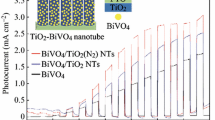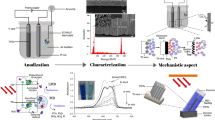Abstract
A comparative study on the photoelectrocatalytic activity of anodic TiO2 nanotubes (TNTs) and boron-doped TiO2 nanotubes (BTNTs) was performed through fabricating them in two distinguished fluoride-containing electrolytes, namely NH4F and NH4BF4. Furthermore, by applying anodization voltage (in the range of 40–60 V) as a regulating factor, an analogy was drawn between morphologies, optical properties, photoelectrochemical features, and photoelectrocatalytic activities of both TNTs and BTNTs. The results revealed that using NH4BF4 not only led to the introduction of boron into TiO2 lattices but also resulted in shorter nanotubes owing to their less corrosive effect compared with NH4F. Furthermore, anodization voltage had a significant impact on the optical properties; with increasing the voltage to 60 V, a red shift occurred in the band edge of both TNTs (from 3.05 to 2.8 eV) and BTNTs (from 2.9 to 2.6 eV). Particularly, via anodization at 60 V in NH4BF4 instead of NH4F, the photocurrent density and photoconversion efficiency increased from 0.19 to 0.67 Ma cm−2 and from 0.12 to 0.270%, respectively. Moreover, methylene blue degradation tests showed that BTNTs had an outstanding photoelectrocatalytic activity in comparison to TNTs; in this regard, the sample synthesized at 60 V in NH4BF4 rather than NH4F enhanced PEC degradation efficiency from 79 to 100% under UV irradiation. Finally, the kinetics investigation confirmed that all photoelectrocatalytic reactions in both groups followed the first-order kinetics.

Graphical abstract













Similar content being viewed by others
References
Abdollahi Y, Abdullah AH, Zainal Z, Yusof NA (2011) Photocatalytic degradation of p-cresol by zinc oxide under UV irradiation. Int J Mol Sci 13:302–315
Wang H, Liu X, Wang S, Li L (2018) Dual templating fabrication of hierarchical porous three-dimensional ZnO/carbon nanocomposites for enhanced photocatalytic and photoelectrochemical activity. Appl Catal B 222:209–218
Georgieva J, Valova E, Armyanov S, Philippidis N, Poulios I, Sotiropoulos S (2012) Bi-component semiconductor oxide photoanodes for the photoelectrocatalytic oxidation of organic solutes and vapours: a short review with emphasis to TiO2-WO3 photoanodes. J Hazard Mater 211-212:30–46
Gilani N, Pasikhani JV, Motie PT, Akbari M (2019) Fabrication of quantum cu(II) nanodot decorated TiO2 nanotubes by the photochemical deposition-assisted hydrothermal method: study catalytic activity in hydrogen generation. Desalin Water Treat 139:145–155
Su Y-F, Chou T-C (2005) Comparison of the photocatalytic and photoelectrocatalytic decolorization of methyl orange on sputtered TiO2 thin films. Z Naturforsch 60b:1158–1167
Pasikhani JV, Gilani N, Pirbazari AE (2018) Improvement the wastewater purification by TiO2 nanotube arrays: the effect of etching-step on the photo-generated charge carriers and photocatalytic activity of anodic TiO2 nanotubes. Solid State Sci 84:57–74
Wang H, Liu X, Niu P, Wang S, Shi J, Li L (2020) Porous two-dimensional materials for photocatalytic and electrocatalytic applications. Matter 2:1377–1413
Ge M, Li Q, Cao C, Huang J, Li S, Zhang S, Chen Z, Zhang K, Al-Deyab SS, Lai Y (2016) One-dimensional TiO2 nanotube photocatalysts for solar water splitting. Adv Sci 4:1600152
Ge M-Z, Cao C-Y, Huang J-Y, Li S-H, Zhang S-N, Deng S, Li Q-S, Zhang K-Q, Lai Y-K (2016) Synthesis, modification, and photo/photoelectrocatalytic degradation applications of TiO2 nanotube arrays: a review. Nanotechnol Rev 5:75–112
Cai J, Shen J, Zhang X, Ng YH, Huang J, Guo W, Lin C, Lai Y (2018) Light-driven sustainable hydrogen production utilizing tio2 nanostructures: a review. Small Methods 3:1800184
Ge M, Cao C, Huang J, Li S, Chen Z, Zhang K-Q, Al-Deyab SS, Lai Y (2016) A review of one-dimensional TiO2 nanostructured materials for environmental and energy applications. J Mater Chem A 4:6772–6801
Lai Y, Gong J, Lin C (2012) Self-organized TiO2 nanotube arrays with uniform platinum nanoparticles for highly efficient water splitting. Int J Hydrog Energy 37:6438–6446
Ge M-Z, Cao C-Y, Li S-H, Tang Y-X, Wang L-N, Qi N, Huang J-Y, Zhang K-Q, Al-Deyab SS, Lai Y-K (2016) In situ plasmonic Ag nanoparticle anchored TiO2 nanotube arrays as visible-light-driven photocatalysts for enhanced water splitting. Nanoscale 8:5226–5234
Bessegato GG, Cardoso JC, Zanoni MVB (2015) Enhanced photoelectrocatalytic degradation of an acid dye with boron-doped TiO2 nanotube anodes. Catal Today 240:100–106
Geng H, Yin S, Yang X, Shuai Z, Liu B (2005) Geometric and electronic structures of the boron-doped photocatalyst TiO2. J Phys Condens Matter 18:87–96
Li J, Lu N, Quan X, Chen S, Zhao H (2008) Facile method for fabricating boron-doped TiO2 nanotube array with enhanced photoelectrocatalytic properties. Ind Eng Chem Res 47:3804–3808
Lu N, Quan X, Li J, Chen S, Yu H, Chen G (2007) Fabrication of boron-doped TiO2 nanotube array electrode and investigation of its photoelectrochemical capability. J Phys Chem C 111:11836–11842
Lu N, Zhao H, Li J, Quan X, Chen S (2008) Characterization of boron-doped TiO2 nanotube arrays prepared by electrochemical method and its visible light activity. Sep Purif Technol 62:668–673
Subramanian A, Wang H-W (2012) Effects of boron doping in TiO2 nanotubes and the performance of dye-sensitized solar cells. Appl Surf Sci 258:6479–6484
Li H, Xing J, Xia Z, Chen J (2014) Preparation of extremely smooth and boron-fluorine co-doped TiO2 nanotube arrays with enhanced photoelectrochemical and photocatalytic performance. Electrochim Acta 139:331–336
Siuzdak K, Szkoda M, Lisowska-Oleksiak A, Grochowska K, Karczewski J, Ryl J (2015) Thin layer of ordered boron-doped TiO2 nanotubes fabricated in a novel type of electrolyte and characterized by remarkably improved photoactivity. Appl Surf Sci 357:942–950
Pasikhani JV, Gilani N, Pirbazari AE (2018) The correlation between structural properties, geometrical features, and photoactivity of freestanding TiO2 nanotubes in comparative degradation of 2,4-dichlorophenol and methylene blue. Mater Res Express 5:025016
Pasikhani JV, Gilani N, Pirbazari AE (2016) The effect of the anodization voltage on the geometrical characteristics and photocatalytic activity of TiO2 nanotube arrays. Nano-Struct Nano-Objects 8:7–14
Noeiaghaei T, Yun J-H, Nam SW, Zoh KD, Gomes VG, Kim JO, Chae SR (2015) The influence of geometrical characteristics on the photocatalytic activity of TiO2 nanotube arrays for degradation of refractory organic pollutants in wastewater. Water Sci Technol 71:1301–1309
Khudhair D, Bhatti A, Li Y, Hamedani HA, Garmestani H, Hodgson P, Nahavandi S (2016) Anodization parameters influencing the morphology and electrical properties of TiO2 nanotubes for living cell interfacing and investigations. Mater Sci Eng C 59:1125–1142
Marien CB, Cottineau T, Robert D, Drogui P (2016) TiO2 nanotube arrays: influence of tube length on the photocatalytic degradation of Paraquat. Appl Catal B 194:1–6
Yoo H, Oh K, Lee YR, Row KH, Lee G, Choi J (2017) Simultaneous co-doping of RuO2 and IrO2 into anodic TiO2 nanotubes: a binary catalyst for electrochemical water splitting. Int J Hydrog Energy 42:6657–6664
Janekbary KK, Gilani N, Pirbazari AE (2020) One-step fabrication of Ag/RGO doped TiO2 nanotubes during anodization process with high photocatalytic performance. J Porous Mater. https://doi.org/10.1007/s10934-020-00954-5
Dolgonos A, Mason TO, Poeppelmeier KR (2016) Direct optical band gap measurement in polycrystalline semiconductors: a critical look at the Tauc method. J Solid State Chem 240:43–48
Yang K, Dai Y, Huang B (2007) Origin of the photoactivity in boron-doped anatase and rutile TiO2 calculated from first principles. Phys Rev B 76:1952011–1952016
Khaki MRD, Shafeeyan MS, Raman AAA, Daud WMAW (2017) Application of doped photocatalysts for organic pollutant degradation - a review. J Environ Manag 198:78–94
Khan S, Al-Shahry M, Ingler WB Jr (2002) Efficient photochemical water splitting by a chemically modified n-TiO2. Science 297:2243–2245
Aliabadi BG, Gilani N, Pasikhani JV, Pirbazari AE (2020) Boosting the photoconversion efficiency of TiO2 nanotubes using UV radiation-assisted anodization as a prospective method: an efficient photocatalyst for eliminating resistant organic pollutants. Ceram Int 46:19942–19951
Dimitrov M, Ivanova R, Velinov N, Henych J, Slušná M, Štengl V, Tolasz J, Mitov I, Tsoncheva T (2016) Mesoporous TiO2 powders as host matrices for iron nanoparticles. Effect of the preparation procedure and doping with Hf. Nano-Struct Nano-Objects 7:56–63
Zheng X, Li D, Li X, Yu L, Wang P, Zhang X, Fang J, Shao Y, Zheng Y (2014) Photoelectrocatalytic degradation of rhodamine B on TiO2 photonic crystals. Phys Chem Chem Phys 16:15299–15306
Qin L, Chen Q, Lan R, Jiang R, Quan X, Xu B, Zhang F, Jia Y (2015) Effect of anodization parameters on morphology and photocatalysis properties of TiO2 nanotube arrays. J Mater Sci Technol 31:1059–1064
Lv Y, Pan C, Ma X, Zong R, Bai X, Zhu Y (2013) Production of visible activity and UV performance enhancement of ZnO photocatalyst via vacuum deoxidation. Appl Catal B 138-139:26–32
Acknowledgments
The authors would gracefully like to acknowledge Iran National Science Foundation (INSF) with Grant No: 97025674 for their unspeakable financial support.
Nomencalture
ERHE Reversible hydrogen electrode potential (V).
EAg/AgCl Ag/AgCl electrode potential (V).
E°Ag/AgCl Ag/AgCl standard electrode potential (V).
Dint Nanotubes’ inner diameter (nm).
L Nanotubes’ length (μm).
w Nanotubes’ wall thickness (nm).
Dext Nanotubes’ outer diameter (nm).
SA Nanotubes’ surface area (m2 m−2).
α Light absorption constant.
ϑ Radiation frequency.
A Planck constant.
Eg Band gap energy (eV).
ε Photoconversion efficiency.
jp Photocurrent density (mA cm−2).
E°rev Reversible standard potential (V).
Eapp Absolute potential applied to the photoanode (V).
I0 Intensity of light radiation.
Emeas Photoanode potential (V).
Eoc Open–circuit potential of photoanode (V).
C0 Initial concentration of methylene blue (ppm).
C Concentration of methylene blue at time “t” (ppm).
r Photoelectrocatalytic reaction rate (ppm min−1).
K Adsorption constant.
k Rate constant (min−1).
t Photoelectrocatalytic degradation time (min).
kapp Apparent rate constant (min−1).
UV Ultra-violet radiation.
Funding
The authors has financial support from the Iran National Science Foundation (INSF) with Grant No: 97025674.
Author information
Authors and Affiliations
Corresponding author
Additional information
Publisher’s note
Springer Nature remains neutral with regard to jurisdictional claims in published maps and institutional affiliations.
Rights and permissions
About this article
Cite this article
Habibi, R., Gilani, N., Pasikhani, J.V. et al. Improved photoelectrocatalytic activity of anodic TiO2 nanotubes by boron in situ doping coupled with geometrical optimization: Application of a potent photoanode in the purification of dye wastewater. J Solid State Electrochem 25, 545–560 (2021). https://doi.org/10.1007/s10008-020-04825-6
Received:
Revised:
Accepted:
Published:
Issue Date:
DOI: https://doi.org/10.1007/s10008-020-04825-6




